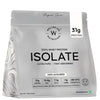Ever wondered why protein is such a big deal in fitness and nutrition? The secret lies in amino acids—the tiny compounds that make up protein and play a huge role in muscle growth, recovery, and overall health. However, not all amino acids are created equal.
Some your body can make it on its own, while others must come from food. That’s where essential and non-essential amino acids come in. Knowing the difference can help you make smarter food choices, whether you're aiming for better workouts, faster recovery, or just a healthier lifestyle. Let’s break it down!
What Are Amino Acids?
Amino acids are organic compounds that form proteins, which are crucial for muscle growth, immune function, and overall health. There are 20 amino acids in total, and they’re divided into:
-
Essential Amino Acids (EAAs) – The body cannot produce these, so they must come from food or supplements. There are nine essential amino acids:
-
Histidine
-
Isoleucine
-
Leucine
-
Lysine
-
Methionine
-
Phenylalanine
-
Threonine
-
Tryptophan
-
Valine
-
Non-Essential Amino Acids – The body can produce these on its own, even if you don’t get them from food. Some common non-essential amino acids include:
-
Alanine
-
Arginine
-
Aspartic Acid
-
Cysteine
-
Glutamic Acid
-
Glutamine
-
Glycine
-
Proline
-
Serine
-
Tyrosine
Key Differences Between Essential and Non-Essential Amino Acids
1. Source of Intake
-
Essential Amino Acids – Must come from food or supplements.
-
Non-Essential Amino Acids – Naturally produced by the body.
For example, if your diet lacks tryptophan (an essential amino acid), your body can’t make it on its own. But it can produce glycine or glutamine from other nutrients.
2. Role in Muscle Growth and Recovery
-
Essential amino acids (especially Branched-chain amino acids or BCAAs like leucine, isoleucine, and valine) play a significant role in muscle protein synthesis. This is why they’re often included in sports nutrition supplements.
-
Non-essential amino acids also contribute to muscle repair but are not as directly involved in stimulating new muscle growth.
3. Impact on Metabolism and Immunity
-
Essential amino acids like methionine help regulate metabolism and fat breakdown.
-
Non-essential amino acids like glutamine and arginine support immune function and digestion.
4. Food Sources
Since your body doesn’t produce EAAs, it’s crucial to get them from high-protein foods. Here’s how you can include them in an Indian diet:
Rich Sources of Essential Amino Acids
-
Animal-Based Foods: Eggs, dairy (paneer, curd, milk), chicken, fish.
-
Vegetarian/Vegan Sources: Quinoa, soy, lentils (dal), chickpeas, nuts, and seeds.
Foods High in Non-Essential Amino Acids
-
Whole grains like brown rice and oats
-
Fruits and vegetables (spinach, cabbage, mushrooms)
-
Nuts and seeds (almonds, sunflower seeds)
Do You Need to Supplement Amino Acids?
If you have a well-balanced diet, you’re likely getting enough amino acids from food. However, if you’re an athlete, bodybuilder, or on a restrictive diet (like veganism), EAA or BCAA supplements can help meet your protein needs.
Both essential and non-essential amino acids play vital roles in the body. While your body can produce some amino acids, it cannot make essential ones, so a balanced diet is crucial. Whether you’re focusing on muscle growth, energy, or overall health, getting the right mix of amino acids is key to staying strong and active.
































 DOWNLOAD NOW
DOWNLOAD NOW
